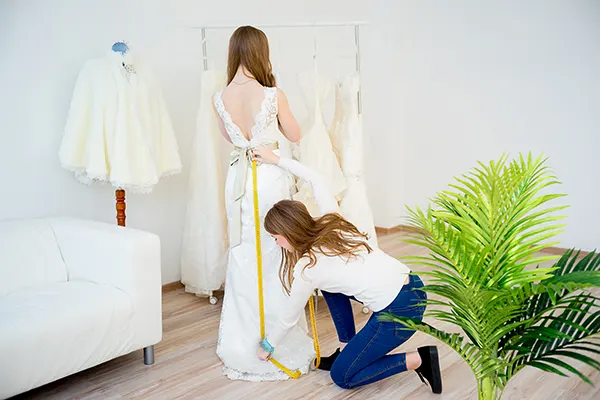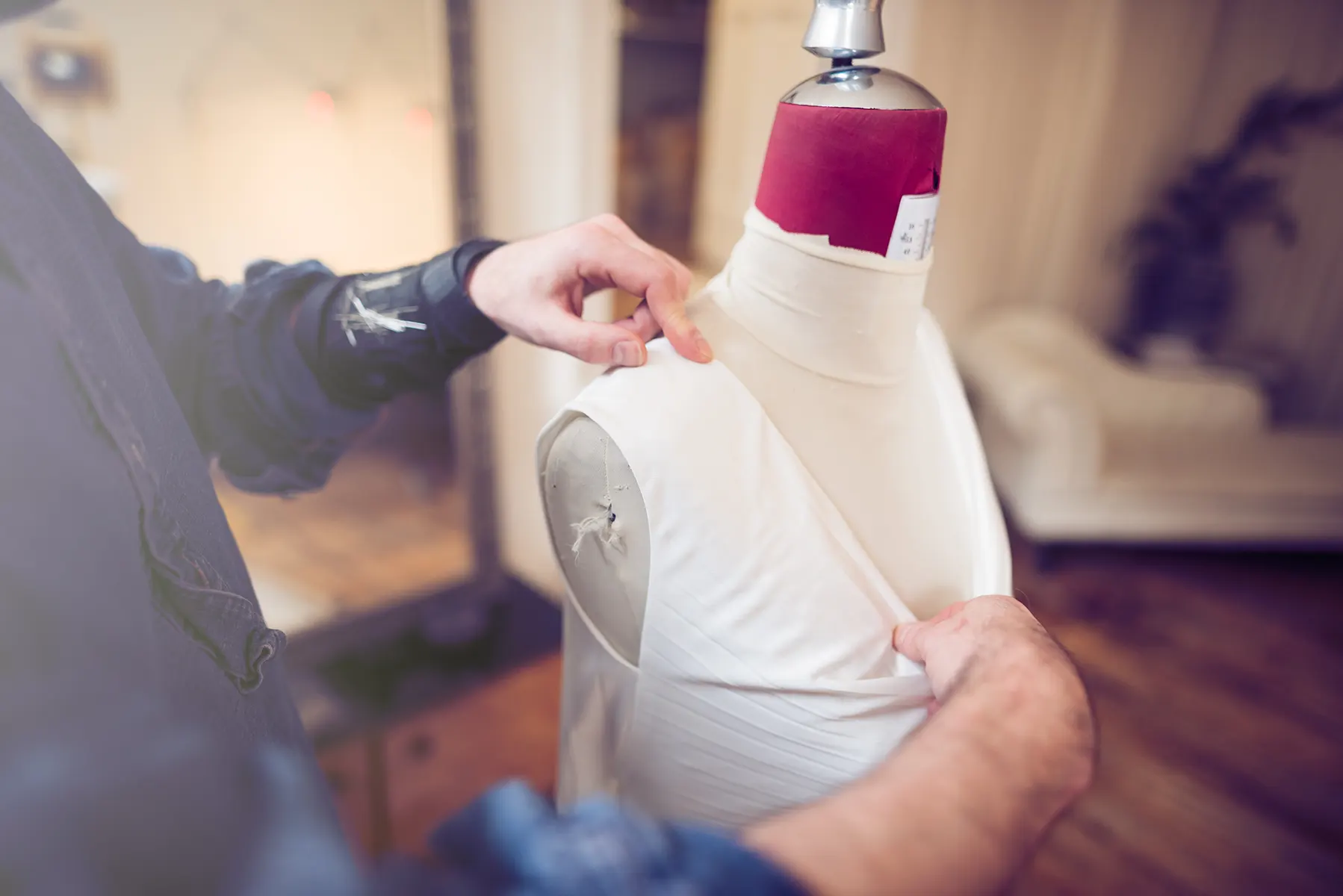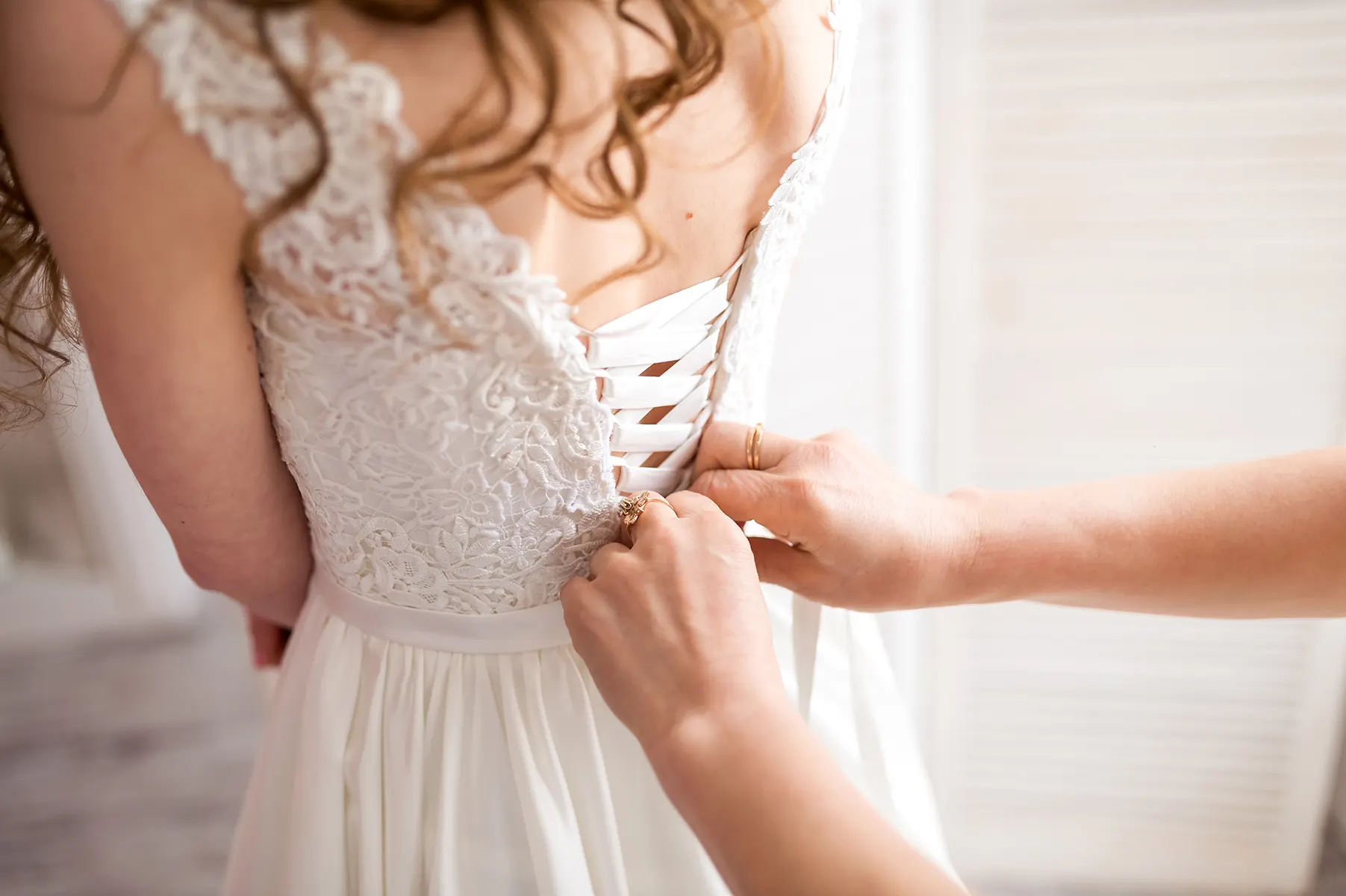
You’ve found the dress, but what happens if it’s not a perfect fit straight off the rack?
Whether it’s a hem that needs shortening, a bodice that needs refining, or straps that need support, alterations are a normal and essential part of finalizing your bridal look.
Below, The Dressing Room reveals what every bride should know about the wedding dress alteration process, including:
- Why alterations matter for every bride.
- What to expect.
- What can (and can’t) be changed.
- How to ensure the perfect fit for your body.
- Pro tips for simplifying your experience.

Do Bridal Dress Alterations Really Matter?
Yes, alterations matter because they ensure:
- Your gown hugs you in the right places, and not in the wrong ones.
- Movement feels natural and effortless throughout your day.
- Your unique proportions and posture are accounted for in every detail.
- A gown that’s beautifully tailored will elevate your look, your photos, and your confidence.
In fact, most wedding dresses were never designed to fit your exact measurements right out of your local bridal boutique. Even couture-level gowns are made using standard sizing.
From petite to plus-size wedding dresses, nearly every bride requires adjustments to achieve the ideal silhouette, length, and level of comfort.
Read “8 Styling Mistakes to Avoid” for more information about the importance of bridal dress alterations.
The Bridal Alteration Process: Step-by-Step
Most brides will attend two to three fittings in the months leading up to their wedding. Here’s what to expect at each stage:
- 6-8 Weeks Before The Big Day: Your First Fitting
- 2-4 Weeks Before The Big Day: Your Second Fitting
- 1-2 Weeks Before The Big Day: Your Final Fitting
1. Your First Fitting (6–8 Weeks Out)
This is the big one. You’ll try on your gown with your bridal undergarments, shoes, and any shapewear you plan to wear. Your seamstress will assess where the dress needs to be taken in, let out, shortened, or reshaped.
Pro Tip: Your seamstress can only work with what’s there. If you’re planning to lose weight or make other physical changes, it’s best to wait until you’re close to your goal to begin alterations.
2. Your Second Fitting (2–4 Weeks Out)
Here, you’ll try on your gown with the initial alterations complete. Adjustments are often made to fine-tune the bust, waist, or neckline.
For gowns with sleeves or detailed beading, this appointment is especially important to assess comfort and mobility.
If something doesn’t feel right, this is also a good time to ask for additional support, such as built-in cups, stronger boning, or discreet adjustments for underarm or back coverage.
3. Your Final Fitting (1–2 Weeks Out)
At your final appointment, the goal is simple: make sure everything is perfect.
Your dress should feel secure but comfortable, with smooth seams and no unexpected shifting. Walk, sit, dance, and take a few spins. If it doesn’t feel flawless, say so.
Read “8 Things You Should Expect When You Visit a Bridal Gown Shop” to ensure you’re informed & prepared.

What are the Standard Alterations for a Wedding Dress?
A skilled sewist can work magic, but not everything is possible (or advisable). Here’s a quick guide:
| Common Alterations | Less Common, but Possible | Rarely Possible or Not Recommended |
| Hemming the skirt | Reshaping the neckline | Changing the entire silhouette |
| Taking in or letting out seams | Adding sleeves or straps | Drastically increasing dress size |
| Adjusting straps or sleeves | Modifying back or train length | Replacing heavy beading or lace |
| Adding bustle points | Reinforcing bodice structure | Completely redesigning the dress |
Note: Gowns with limited seam allowance (especially in ready-to-wear collections) may only allow for minimal adjustments. This is especially important for brides who need dresses taken out rather than taken in.
How to Get the Best Fit for Your Body Type
The perfect fit isn’t about size, it’s about proportion, structure, and styling. Here’s how brides of all shapes and sizes can set themselves up for success:
- Choose a gown close to your current size. It’s easier to take a dress in than let it out.
- Look for structure where you want it. Built-in boning, corsetry, and quality lining can help support your figure from the start, and reduce the number of alterations needed.
- Be honest about how it feels. Especially for anyone wearing plus-size wedding gowns, it’s vital to speak up if something is pinching, sagging, or shifting. Your comfort is just as important as the final look.
How Much Should You Expect to Pay for Wedding Dress Alterations?
Plan for anywhere from $300 to over $800, depending on your gown’s complexity.
What Should You Bring to Your Bridal Gown Alteration Appointment?
Your wedding shoes, bra, shapewear, and veil (if you plan to wear one) will affect how your dress sits on your body.
Find Your Gown & Get Sewist Recommendations at The Dressing Room
Your wedding dress should never feel like something you have to “make work.” With the right alterations, and a seamstress who listens to your needs, you can ensure your gown flatters, supports, and celebrates your body.
At The Dressing Room, we don’t provide alteration services in-house, but we do want your entire journey to be stress-free. Whether you’re searching for minimalist elegance or something with head-to-toe sparkle, our expert stylists are ready to guide you toward a dress you’ll love, before and after tailoring.
For personalized support finding the right dress and the best sewist for your vision, book an appointment today.

